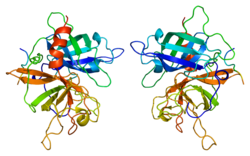Tissue-specific plasminogen activator
| Tissue-specific plasminogen activator | ||
|---|---|---|

|
||
|
Existing structural data : 1A5H , 1BDA , 1PK2 , 1PML , 1RTF , 1TPG , 1TPK , 1TPM , 1TPN |
||
| Properties of human protein | ||
| Mass / length primary structure | 527 = 275 + 257 amino acids | |
| Secondary to quaternary structure | Heterodimer | |
| Cofactor | fibrin | |
| Isoforms | 4th | |
| Identifier | ||
| Gene names | PLAT T-PA; TPA | |
| External IDs | ||
| Drug information | ||
| ATC code |
B01 AD02 S01 XA13 |
|
| Drug class | Fibrinolytic | |
| Enzyme classification | ||
| EC, category | 3.4.21.68 , serine protease | |
| MEROPS | S01.232 | |
| Substrate | Arg - + - Val in plasminogen | |
| Products | Plasmin | |
| Occurrence | ||
| Homology family | Trypsin | |
| Parent taxon | Creature | |
| Orthologue | ||
| human | House mouse | |
| Entrez | 5327 | 18791 |
| Ensemble | ENSG00000104368 | ENSMUSG00000031538 |
| UniProt | P00750 | P11214 |
| Refseq (mRNA) | NM_000930 | NM_008872 |
| Refseq (protein) | NP_000921 | NP_032898 |
| Gene locus | Chr 8: 42.18 - 42.21 Mb | Chr 8: 22.76 - 22.78 Mb |
| PubMed search | 5327 |
18791
|
The tissue-specific plasminogen activator (English: tissue-type plasminogen activator , t-PA) is an enzyme that is released from the endothelial cells of the vessel wall and acts as the body's own activator of fibrinolysis . It is a serine protease that converts plasminogen directly into plasmin and thus inhibits blood clotting . Inhibitors of t-PA formed in the blood are called plasminogen activator inhibitors .
A genetically engineered variant, alteplase or recombinant (tissue-type) plasminogen activator (English: recombinant tissue-type plasminogen activator , rt-PA) is used therapeutically for dissolution of thrombus ( thrombolysis used).
Alteplase
Alteplase is the generic name of the recombinant tissue-specific plasminogen activator (rt-PA). The drug is used parenterally as a fibrinolytic to dissolve blood clots ( thrombi ) in various vascular diseases ( thrombolysis ).
The biotechnologically produced active ingredient alteplase corresponds to an endogenous glycoprotein, has a molecular weight of 131,000, a half-life of six minutes (terminal half-life: about 30 minutes), is eliminated after metabolism in the liver and mimics the effect of the natural tissue-specific plasminogen activator. It works primarily by converting plasminogen bound to fibrin into plasmin, whereby it forms a complex on the fibrin surface. Related substances with a direct fibrinolytic effect are tenecteplase and reteplase . Streptokinase and urokinase also have a similar but indirect fibrinolytic effect .
Indications
Alteplase is approved in Germany for the following clinical pictures:
- Myocardial infarction (if coronary intervention with appropriate recanalization is not available within acceptable periods of time)
- acute ischemic stroke
- acute massive pulmonary artery embolism
The dosage depends, among other things, on whether a deep vein thrombosis , a heart attack, an arterial occlusion , a pulmonary embolism or an acute ischemic stroke is to be treated.
A fundamental distinction must be made between local and systemic lysis therapy. In local lysis therapy, the fibrinolytic is applied close to the site of action by means of catheter intervention, e.g. B. a leg artery acutely occluded by a blood clot is injected. In systemic lysis therapy, the fibrinolytic is injected into the body's circulation through a peripheral vein.
When using all fibrinolytic substances, a strict risk-benefit assessment must be made, as serious side effects in the form of insatiable and potentially fatal bleeding can occur.
Trade names
The enzyme rt-PA (Alteplase) is commercially available in Germany, Austria and Switzerland under the name Actilyse in vials of 10 to 100 mg.
literature
- T. Karow, R. Lang-Roth: General and special pharmacology and toxicology. Self-published, 2007.
- HM Hoffmeister: Assessment of old and new thrombolytics in acute myocardial infarction: indication, caveats and expectations. (PDF; 931 kB) In: Journal for Cardiology. 9 (Supplementum C), 2002, pp. 3-5.
- J. Madhani, H. Movsowitz, MN Kotler: Tissue plasminogen activator (t-PA). In: Ther Drug Monit . 15 (6), Dec 1993, pp. 546-551. Review. PMID 8122292
Individual evidence
- ↑ Jörg Braun: Blood, blood products and coagulation disorders. In: Jörg Braun, Roland Preuss (Ed.): Clinic Guide Intensive Care Medicine. 9th edition. Elsevier, Munich 2016, ISBN 978-3-437-23763-8 , pp. 539-579, here: pp. 547-551 ( fibrinolytics ), in particular p. 550 ( Alteplase ).
- ↑ Jörg Braun (2016), p. 550.
- ↑ Red List online, as of September 2009.
- ↑ AM comp. d. Switzerland, as of September 2009.
- ↑ AGES-PharmMed, as of September 2009.